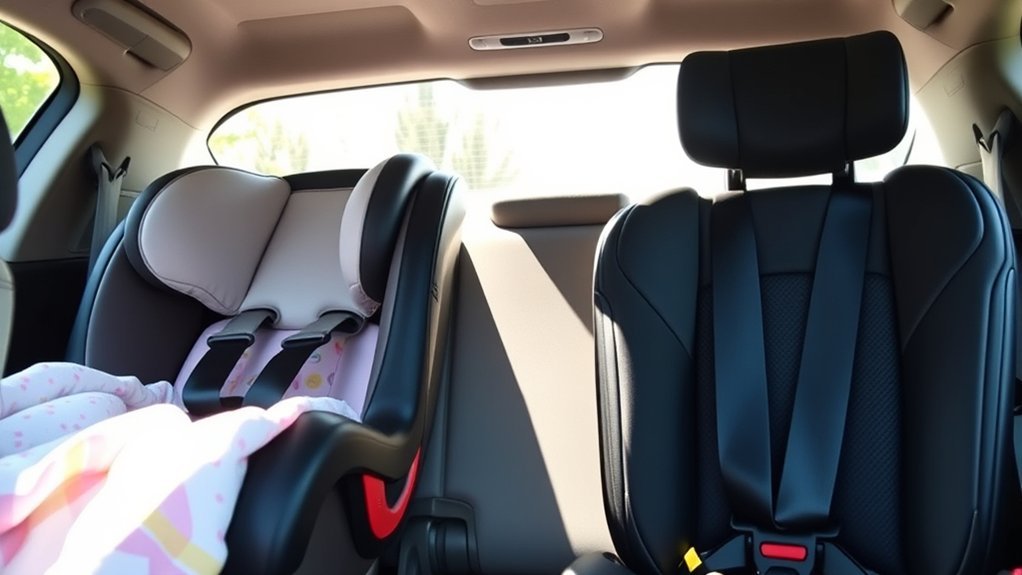Choosing the right car seat can feel like a life-or-death decision, but it doesn’t have to be overwhelming. Understanding the differences between infant and convertible seats is vital for your child’s safety. Each option has unique benefits and requirements, and knowing how to use them properly is important. So, what should you prioritize to guarantee maximum protection while on the road? Let’s explore the key factors that will guide your choice.
Understanding Infant Car Seats
When it comes to your baby’s safety during car travel, understanding infant car seats is essential. These seats are specifically designed for newborns and small infants, providing the appropriate support and protection.
Understanding infant car seats is crucial for your baby’s safety, offering essential support and protection for newborns and small infants.
They typically feature a rear-facing orientation, which is important for head and neck support in the event of a collision.
When choosing an infant car seat, check for the appropriate weight and height limits to guarantee a proper fit. Look for a seat that meets safety standards and has a five-point harness system.
Proper installation is critical; always follow the manufacturer’s guidelines and consider using a certified technician for assistance.
Regularly check the fit as your baby grows, confirming their safety during each journey.
Exploring Convertible Car Seats
Infant car seats serve a specific purpose for newborns, but as your child grows, convertible car seats become a practical choice.
These seats shift from rear-facing to forward-facing, accommodating your child’s development. Here are four key benefits to evaluate:
- Longevity: Convertible seats can be used from infancy through toddlerhood, saving you money in the long run.
- Versatility: They adapt to your child’s size and weight, offering multiple recline positions for comfort.
- Ease of Use: Many models feature straightforward installation systems, making it easier for you to switch between vehicles.
- Safety Ratings: Convertible seats often meet or exceed safety standards, ensuring your child stays protected as they grow.
Choosing the right convertible seat is essential for your child’s safety and comfort.
Safety Features to Consider
As you choose a convertible car seat, considering safety features is essential for your child’s protection.
Look for a seat that has a five-point harness system, which securely restrains your child in case of an accident. Also, check for side-impact protection to help shield your child from lateral collisions.
An adjustable headrest allows you to customize the fit as your child grows, guaranteeing optimal safety. Additionally, review the seat’s crash test ratings; higher ratings indicate better performance in accidents.
Finally, opt for a model with easy installation features, like LATCH systems or color-coded indicators, to make sure you install it correctly every time.
Prioritizing these features guarantees your child’s safety on every journey.
Transitioning Between Car Seats
Choosing the right time to move your child from an infant car seat to a convertible seat can greatly impact their safety and comfort.
Choosing the optimal moment to transition from an infant car seat to a convertible seat is crucial for your child’s safety and comfort.
To guarantee a smooth shift, consider these factors:
- Weight and Height Limits: Check the manufacturer’s guidelines for both seats.
- Developmental Milestones: Your child should be able to sit up unassisted and have head control.
- Age Recommendations: Generally, shift after your child reaches at least 12 months old.
- Usage Frequency: If you’re frequently transporting your child, a convertible seat might be more practical.
Best Practices for Car Seat Installation
While guaranteeing your child’s safety during car rides is essential, proper installation of the car seat is just as important.
First, always read the car seat manual and your vehicle’s owner manual to understand specific guidelines.
Position the seat at the correct angle; most infant seats require a slight recline. Use the LATCH system if available, as it can simplify installation.
Make sure the seat is tightly secured; it shouldn’t move more than an inch side-to-side or front-to-back at the belt path.
If using a seatbelt, verify it’s locked and that the harness fits snugly against your child’s body.
Finally, regularly check the installation, especially after long trips or if the seat has been removed.
Safety starts with proper installation.
Frequently Asked Questions
How Do I Choose the Best Car Seat for My Baby?
To choose the best car seat for your baby, consider safety ratings, your child’s age and weight, ease of installation, and compatibility with your vehicle. Always follow manufacturer guidelines for maximum protection and comfort.
When Should I Stop Using an Infant Car Seat?
You should stop using an infant car seat when your baby exceeds the weight limit, typically around 30-35 pounds, or reaches the height limit, usually 30-32 inches. Safety regulations vary, so always check guidelines.
Can I Use a Convertible Seat for a Newborn?
Yes, you can use a convertible seat for a newborn, but make certain it has a low weight limit and proper recline. Always check the manufacturer’s guidelines for safety and fit for your baby’s size.
What Are the Weight Limits for Infant and Convertible Seats?
Infant seats typically accommodate newborns up to 30-35 pounds, while convertible seats often support children from 5 to 65 pounds. Always check the specific model’s guidelines to guarantee safety and compliance with weight limits.
Are There Any Recalls on Car Seats I Should Know About?
Yes, you should check for car seat recalls regularly. The National Highway Traffic Safety Administration (NHTSA) website provides up-to-date information on any recalls, ensuring your child’s safety in the car. Stay informed and proactive.
Conclusion
In the journey of parenthood, choosing the right car seat is essential for your little one’s safety. Whether you opt for an infant seat or a convertible one, each has its unique benefits. By staying informed about installation best practices and safety features, you can guarantee your child travels securely. Remember, it’s not just about the seat; it’s about peace of mind knowing you’re providing the best protection as you navigate life’s adventures together.
